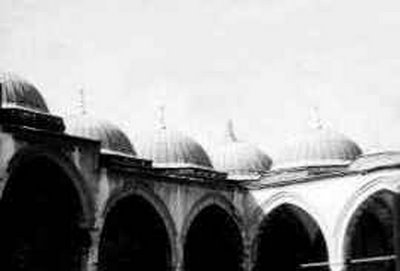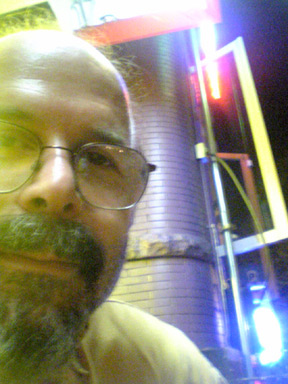Thinking about Ecphrasis

 1. Vivid description; using details to place an object, person, or event before the listeners' eyes (= hypotyposis or evidentia). See also enargia.
1. Vivid description; using details to place an object, person, or event before the listeners' eyes (= hypotyposis or evidentia). See also enargia.
2. The Greek term for the progymnasmata exercise called description: a "composition bringing the subject clearly before the eyes." Like the encomium, the subjects may be persons, actions, times, places, animals, and growing things.

3. Ecphrasis has another more restricted definition: the literary description of a work of art. Philostratus Lemnius helped to fix this more restricted sense of this term in the second century in his Imagines.

Such anyway is an academic, classical definition of ecphrasis.
 [ side-note / tangent:
[ side-note / tangent:The Latin word imagines is the plural of imago. Imagines were used in funeral processions to show the status of one's ancestors. The imago was a wax mask of an ancestor. Only the senatorial class was allowed to have imagines. ]
 Some modern writers employ ecphrasis to denote a literary practice involving fabulating a narrative (poem or story) based on contemplation of a photographic image -- an exercise more of imagination than description.
Some modern writers employ ecphrasis to denote a literary practice involving fabulating a narrative (poem or story) based on contemplation of a photographic image -- an exercise more of imagination than description.
Ashish Gorde, who shot this photo at the Blue Mosque in Istanbul, submitted the image to a network of writers for an ecphrasis exercise. (My particular response to the procedure can be seen here on the present blog.)
A few weeks later, Ashish voiced questions about the practice per se -- titling his post, "What's the big deal with ecphrasis anyway??"

He seemed to be trying to make sense of the exercise: its objective, the relationship between writing and image, the integrity of the original image (sans writing), etc.
 I composed the following rumination by way of a reply to that line of inquiry.
I composed the following rumination by way of a reply to that line of inquiry.Well, a photograph is one thing -- its esthetic scope, within its own sphere, is what it is. It is perceived directly by the eyes. The mind, then, must make of it what it will.

Any narrative the image might contain or imply, is nascent, latent, unexpressed, undeveloped, in seed-form. The eye perceives, the mind (potentially) interprets. Interpretation can vary widely.
 A specimen of writing is another thing. It has its own materials (words rather than pixels or gradations of tint) and gives rise to its own mode of operation. It's a constructive process (both the writing and the reading), in the sense that the text unfolds in a linear fashion, beginning with a first word and ending with a last word -- and building something along the way.
A specimen of writing is another thing. It has its own materials (words rather than pixels or gradations of tint) and gives rise to its own mode of operation. It's a constructive process (both the writing and the reading), in the sense that the text unfolds in a linear fashion, beginning with a first word and ending with a last word -- and building something along the way. So,
So,narrative:
a time-based
process,
a series
of
sound-symbols
(graphically recorded)
that only
make sense
when replayed
(read) in the
conventional
order.
Thus, an "experience" in decidedly linear (sequential) terms.

The photograph mediates between the physical world as it exists at a particular moment and place, and the perceptual experience of a viewer who may look at the photo, somewhere else -- that bygone moment recorded, that condition of light and space and physical matter now abstracted into a representation, a 2-dimensional image. The image can be read "linearly" somewhat, perhaps -- but for the most part no. For the most part, the image is taken in as a whole. It has various elements (spatially arrayed); and the eye, roving over these elements, does so in time: so there is (possibly) a time process involved, but if so, it's significnatly less directed, less orchestrated, less predictable, less definable even, than is the time process (the clearly fixed sequence of first this word, then that word, phrase after phrase) which a reader perforce experiences when reading a text.

Any plurality of thoughts latent in the image are unlikely to be reeled out in some specific sequential form. (For that kind of thing, you need a sequence of images. This takes us in the direction of film.) The photographic image in itself might contain much information. But it lacks a directional "reading order." To the degree the mind (on some occasion) spins out a story from the image, one could say the observer is in that case undergoing a "natural ecphrasis experience": he is "reading" meanings into the image, or anyway thinking about it, perhaps even in a sequence of thoughts. This could involve either analysis or imagination. Either way, the image remains static. Despite the roving of the eye over its surface, despite some range of thoughts it might arouse, the picture lays flat on page or screen, presenting a sense of stillness, and an overall sense of unbroken unity, an integrated whole. [That I've broken up this image for display here, cuts against the grain of this last remark. In breaking up the image, I'm altering the standard way of seeing it, perhaps allowing for a sense of "reading" it, though this sense seems rudimentary, somewhat like a silent movie.]
 Writing, as noted, is overtly sequential (as it proceeds to be read). The writing, however, once it has been read, is now a thing lodged in memory. After one has read the [story/poem/paragraph],
Writing, as noted, is overtly sequential (as it proceeds to be read). The writing, however, once it has been read, is now a thing lodged in memory. After one has read the [story/poem/paragraph], perhaps its linearity "goes out of focus," and its wholeness can begin to come into focus. The response (intellectual, esthetic, emotional, ideational) to this wholeness would seem to be the overall response of the reader to the text. The overall response is perhaps the essential response.
perhaps its linearity "goes out of focus," and its wholeness can begin to come into focus. The response (intellectual, esthetic, emotional, ideational) to this wholeness would seem to be the overall response of the reader to the text. The overall response is perhaps the essential response.The reader responds to individual words, and to sentences, and finally, to the whole story.

Here -- in the overall response of the reader (listener) -- the writing (the story) finally attains its unity.
If the writing makes an impact, isn't that impact analogous to the visual impact of a photograph? It exists in parts (words / sentences); but it seeks to convey a meaning beyond the individual words: a transcendent unity: a unity analogous to the unity of the photograph. Hence one could say, the story desires to be a photo.
 But doesn't the photograph seek to be a piece of writing? -- to be developed, sprouted out of seed-form into the multiple facets of its potential life? Illuminated in all the diversity of its details and implications? Doesn't it want to be savored in a sequence of observations?, to have its overload of all-at-once information meted out piecemeal, inch by inch, element by element? It exists in the heavens (unity), but desires the joy of diversity (earth). It wants all its details delineated -- as in the lineation, the linearity, the line-liness, of the story. It already has wholeness; what it lacks is sequence.
But doesn't the photograph seek to be a piece of writing? -- to be developed, sprouted out of seed-form into the multiple facets of its potential life? Illuminated in all the diversity of its details and implications? Doesn't it want to be savored in a sequence of observations?, to have its overload of all-at-once information meted out piecemeal, inch by inch, element by element? It exists in the heavens (unity), but desires the joy of diversity (earth). It wants all its details delineated -- as in the lineation, the linearity, the line-liness, of the story. It already has wholeness; what it lacks is sequence. Doesn't the photograph silently yearn to find itserlf appreciated in detail, recognized with particularity, granularly exploded into a thousand smithereens -- then gracefully reassembled as a vivid, vocal story? The plotline might stand in (on the path toward a new unity) -- stand in for the old unity of its beginning. A river might reflect the sky (its original oneness), but broken up now by tress, shadows, jumping animals, and traveled by boats.
Doesn't the photograph silently yearn to find itserlf appreciated in detail, recognized with particularity, granularly exploded into a thousand smithereens -- then gracefully reassembled as a vivid, vocal story? The plotline might stand in (on the path toward a new unity) -- stand in for the old unity of its beginning. A river might reflect the sky (its original oneness), but broken up now by tress, shadows, jumping animals, and traveled by boats. I've emphasized the unity of the photograph. But there's another side to this story!
I've emphasized the unity of the photograph. But there's another side to this story!The photograph is a still memory. But memory remembers something. What? motion! The motion of the story from which it was lifted. So its origin, in this sense, is from the world of story (the world of motion). It's been caught and delivered into a timeless suspension. Its direction -- if this frozen stillness should somehow thaw -- would be (again) toward change, sequence, what we might call drama. Activity, rather than repose, would be its direction.
So:
Ecphrasis, I posit, seeks to satisfy these two desires:

the photo's to be a story,

the story's to be a picture.


0 Comments:
Post a Comment
<< Home